Accuracy of predicting the upper arch expansion using the ClinCheck software
- Authors: Pilipenko N.D.1, Maksyukov S.Y.1
-
Affiliations:
- Rostov State Medical University
- Issue: Vol 25, No 2 (2021)
- Pages: 159-166
- Section: Clinical Investigations
- Submitted: 17.03.2022
- Accepted: 17.03.2022
- Published: 15.03.2021
- URL: https://rjdentistry.com/1728-2802/article/view/105059
- DOI: https://doi.org/10.17816/1728-2802-2021-25-2-159-166
- ID: 105059
Cite item
Abstract
BACKGROUND: Among the anomalies of the dentoalveolar system, narrowing of the upper dental arches in a permanent bite occurs in 57% of the cases examined. Aligners are a preferable method for correcting the position of the teeth and expanding dental arches. Planning and modeling treatment outcomes when using clear aligners are essential parts, since it is the quantitative assessment of treatment outcomes that improves clinical practice. The ClinCheck software allows making an almost fully automated design and manufacturing of Invisalign.
AIM: This study aimed to assess the accuracy of predicting the expansion of the upper arch using the ClinCheck software.
MATERIAL AND METHODS: A prospective clinical study included 19 patients with dentoalveolar anomalies whose dental arch parameters were measured before and after treatment with Invisalign Full and Invisalign Teen. Evaluation of the accuracy of predicted expansion using ClinCheck was carried out by comparing the simulated parameters and actual outcomes. To assess the achieved results, individual tooth from the original ClinCheck model was superimposed on the digital model from the post-treatment scan. For the studied parameters, the arithmetic mean was calculated, and significant differences were established at a significance level of p <0.05.
RESULTS: As regards treatment result, patients showed a significant expansion of the upper dental arch in the premolar and molar region as well as protrusion of the incisors. Data showed a high accuracy of prediction using ClinCheck, since no significant differences were found between the mean values obtained as a result of treatment and those predicted using ClinCheck.
CONCLUSIONS: 1) Invisalign technology is effective in widening the upper arch. Following treatment, patients showed significant differences in the width for the first premolars at 4.03±0.24 mm, for the second premolars at 3.61±0.25 mm, for the first molars at 2.11±0.31 (p <0.05), as well as clinically significant incisor protrusion of 6.53±1.41° (p <0.05). 2) Differences between the mean values obtained following treatment and simulated in the ClinCheck program were as follows: expansion along the canines, 0.05±0.11 mm (p >0.05); expansion along the first premolars, −0.04±0.23 mm (p >0.05); expansion along the second premolars, 0.003±0.14 mm (p >0.05); expansion along the first molars, 0.002±0.13 mm (p >0.05), and incisor protrusion, −0.12±0.92° (p >0.05).
Keywords
Full Text
About the authors
Nadezhda D. Pilipenko
Rostov State Medical University
Author for correspondence.
Email: kafstom2.rostgmu@yandex.ru
ORCID iD: 0000-0003-0893-3916
Russian Federation, 29, Nakhichevanskiy all., Rostov-on-Don, 344022
Stanislav Yu. Maksyukov
Rostov State Medical University
Email: kafstom2.rostgmu@yandex.ru
ORCID iD: 0000-0001-7823-8906
MD, Dr. Sci. (Med.), Associate Professor
Russian Federation, 29, Nakhichevanskiy all., Rostov-on-Don, 344022References
- Maksyukov SY, Pilipenko ND, Pilipenko KD. Features of clinical manifestations in patients suffering from dentoalveolar abnormality. Russian Dental Journal. 2020;24(1):19–22. (In Russ). doi: 10.18821/1728-2802-2020-24-1-19-22
- Batista KB, Thiruvenkatachari B, Harrison JE, O’Brien KD. Orthodontic treatment for prominent upper front teeth (Class II malocclusion) in children and adolescents. Cochrane Database Syst Rev. 2018;13(3):CD003452. doi: 10.1002/14651858.CD003452.pub4
- Mohamad IS, Vodolatsky VM. Prevalence of dentoalveolar anomalies and deformities in children and adolescents. Bulletin of New Medical Technologies. 2020;1:7–11. (In Russ). doi: 10.24411/2075-4094-2020-165272
- Arsenina OI, Popova NV, Makhortova PI, Gairbekova LA. Complex diagnostics and treatment of patients with constriction and deformity of the upper jaw. Clinical dentistry.2019;(1):51–57. (In Russ). doi: 10.37988/1811-153X_2019_1_51
- Shakirova RR, Nikolaeva EV, Gilmutdinova LV, et al. The structure of the pathology of the dentoalveolar system of patients referred by a dentist for orthodontic treatment. Vyatka Medical Bulletin. 2019;(2):73–76. (In Russ).
- Nikolaev AV, Andreishchev AR, Kutukova SI. Comparison of the biomechanics of surgically associated palate dilation when using distraction devices with dental and bone fixation types. Dentistry. 2017;96(5):48–55. (In Russ). doi: 10.17116/stomat201796548-55
- Winsauer H, Vlachojannis C, Bumann A, et al. Paramedian vertical palatal bone height for mini-implant insertion: a systematic review. Eur J Orthod. 2014;36(5):541–549. doi: 10.1093/ejo/cjs068
- Arsenina OI, Ryakhovsky AN, Safarova NM, Shishkin KM. Experience of using corrective mouthguards to eliminate crowding of the position of the anterior group of teeth. Orthodontics. 2014;(1):35–43. (In Russ).
- Grunheid T, Gaalaas S, Hamdan H, Larson BE. Effect of clear aligner therapy on the buccolingual inclination of mandibular canines and the intercanine distance. Angle Orthod. 2016;86(1):10–16. doi: 10.2319/012615-59.1
- Brylina KA. Effective use of INVISALIGN aligners in distal movement of maxillary molars: a review of modern foreign scientific literature. Chief Physician of the South of Russia. 2017;(2-1):18–23. (In Russ).
- Boyd RL, Miller RJ, Vlaskalic V. The Invisalign system in adult orthodontics: mild crowding and space closure cases. J Clin Orthod. 2000;34:203–212.
- Kravitz ND, Kusnoto B, BeGole E, et al. How well does Invisalign work? A prospective clinical study evaluating the efficacy of tooth movement with Invisalign. Am J Orthod Dentofacial Orthop. 2009;135(1):27–35. doi: 10.1016/j.ajodo.2007.05.018
- Boyd RL, Vlaskalic V. Three-dimensional diagnosis and orthodontic treatment of complex malocclusions with the invisalign appliance. Semin Orthod. 2001;7(4):274–293. doi: 10.1053/sodo.2001.25414
- Ali SA, Miethke HR. Invisalign, an innovative invisible orthodontic appliance to correct malocclusions: advantages and limitations. Dent Update. 2012;39(4):254–260. doi: 10.12968/denu.2012.39.4.254
- Malik OH, McMullin A, Waring DT. Invisible orthodontics part 1: Invisalign. Dent Update. 2013;40(3):203–204. doi: 10.12968/denu.2013.40.3.203
- Kuo E, Miller RJ. Automated custom-manufacturing technology in orthodontics. Am J Orthod Dentofac Orthop. 2003;123(5):578–581. doi: 10.1067/mod.2003.S0889540603000519
- Lagravère MO, Flores-Mir C. The treatment effects of Invisalign orthodontic aligners: a systematic review. J Am Dent Assoc. 2005;136(12):1724–1729. doi: 10.14219/jada.archive.2005.0117
- Rossini G, Parrini S, Castroflorio T, et al. Efficacy of clear aligners in controlling orthodontic tooth movement: a systematic review. Angle Orthod. 2015;85(5):881–889. doi: 10.2319/061614-436.1
Supplementary files

















